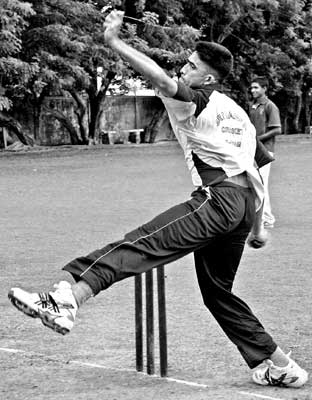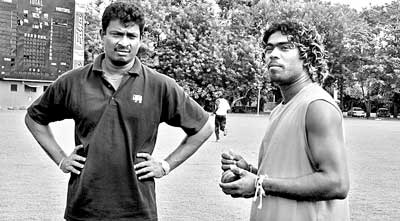
Pace FactoryOver the years the Indian sub-continent has been better known for their wristy stroke players and wily spinners who have mesmerized their opponents. Out of the three giants it was only Pakistan who have had a history of producing fast bowlers of repute while India and Sri Lanka have banked mainly on spinners barring the one-off Kapil Devs that they produce.
There was a certain turning point when in the year 1987 the MRF Fast Bowling Foundation was established in India with former Australian fast bowling legend Dennis Lillee as its director and former Indian fast bowler T.S. Sekar as its head coach. This was a big boost for the Indians and Sri Lanka too reaped benefits from this establishment by sending their leading fast bowlers to learn the finer points of that art for the next decade or so. Then came the Lankan cricket boom. In 1996 Sri Lanka had won the cricket’s major plum and were looking ahead for bigger exploits. With that in mind the Lankan authorities set up its own Pace Factory along with Australian Daryl Foster as consultant and Rumesh Ratnayake – the newly appointed National assistant Coach as the national fast bowling coach. Ratnayake’s assistant was another Lankan fast bowler -- Champaka Ramanayake who took over the reins after the former had been absorbed by the Asian Cricket Council as one of its Development Officers in 2001. However within the past five years or so Sri Lanka too has come up with their battery of fast bowlers challenging each other for their positions in almost every match and almost all of them could unleash a delivery in the in-and-outs of 140Ks per hour – an achievement indeed! One morning this week The Sunday Times took a walk down to the NCC grounds to have a closer look at Sri Lanka’s Pace Factory churning out its products under the watchful eyes of Champaka Ramanayake and his assistant Anusha Samaranayake, another Lankan fast bowler of yore. Ramanayake began to explain how the Sri Lanka Pace Foundation began and how it progressed. “The Sri Lanka Fast Bowling Foundation began in 1999 with Daryl Foster and Rumesh Ratnayake so that the Lankan fast bowlers could have a longer duration of nurturing rather than sending them to the MRF foundation as we had done a decade or so before. In reality this was the very first academy that we started in Sri Lanka. Prior to this we never had anything like this at national level.
“Even at my time we had good fast bowlers in spite of the accent being on spinners. I can remember there was one Test Match where Rumesh, Ravi, Labrooy (Graeme) and I played together. However what we lacked in that era is the exposure as we played very little international cricket. At the same time we also had this hunch with spinners, that after a few overs with fast bowlers we always used to revert to spin bowling because our mindset was there. “Then when we started the Fast Bowling Foundation and the authorities started to take a closer look at them. Our fast bowlers on their part started believing in themselves and from that point onwards the results have been very encouraging. At the same time we play a lot more cricket in this era, so they also have a lot more opportunities. I can remember when I was playing for Sri Lanka in one series I took 17 wickets in a three-match series against none other than Australia on our own spin-oriented wickets, but when you take that I played in only 18 Test matches in the ten years that I represented my country, I had very little opportunity to develop”. Then Sri Lanka’s National Coach for Fast Bowling described how the pattern progressed. “I feel that the exploits of Chaminda Vaas in the international arena in the past ten years or more have also helped the Lankan cricketers to believe that Sri Lanakns could do well in this department. With three hundred plus wickets in his kitty he is a much respected world class fast bowler and a role model to the others. When I took over in 2001 my leading pupils were Ranga Dilhara Fernando, Prabhath Nissanka and a lanky fast bowler from Ragama CC called Gamage. “Now the scrutiny has put through its tentacles to all forms of cricket and we are well in control of the situation. To begin with we have a pool for the under- 15 cricketers where 12 cricketers, under- 19 around 12, Fast Bowling Academy 15, Development Squad 5, A-Team 8 along with the guys who are already in the national team at present. So the upward push is always there and the pressure is on so no one can relax and take things for granted. However initially we made it a point to watch the club matches and pick the guys with potential and draft them into the Academy along with Foster”. Then Champaka Ramanayake came up with another interesting test which they have very successfully completed. He explained “It was an open thing. Anyone who wanted to bowl fast and test his skills could have joined this competition like thing which we conducted in Colombo, Galle, Kandy and Dambulla. There was a turnout of about 1500 participants – some who have never played any substantial cricket at all. At the end we selected ten of them from all over the island. There was a guy who emerged from Habarana and he joined the Chilaw Marians. Out of the ten only one guy from Gampola failed to turn up, but, to my mind he was quite sharp”. Finally Champaka embarked upon the discovery of his life-time. “One day before my tenure at the fast Bowling Academy full time and when Anura Tennekoon was in charge of the Cricket Foundadation he requested me to have a look at some of the cricketers who had failed to make it to the under- 17 squad. I was looking at the bowlers and I was having a knock. Then there was this skinny little sixteen-year-old guy who started to bowl at me. I was amazed with the speed he generated – I am no super bat, but, I was a good enough bat at club level. I just could not hit him in front of the wicket and then I got to know that he was Lasith Malinga from Galle – my own home town. Without any delay I drafted him to my club Galle CC where I had a role as a coach cum player. Then within two years he was playing for my club and he was drafted into the Fast Bowling Academy. At this point we started building him up where he needed the strength to sustain himself as a fast bowler and in no time at my request he was in the national team. However still I am happy for the coach at Vidyaloka Vidyalaya for giving this guy with an unconventional action the opportunity to play the game in the first place. Then once he was going on well we once toyed with the idea of raising his arm a little bit so that we could get him to hit the seam more often, but, we let it lie low when we saw him taking wickets in spite of not hitting the seam on the deck often. However you may have noticed that whenever he hits the seam on the deck the ball always tends to move. My vision as a fast bowling coach is to provide enough ammunition for us to win Test matches overseas on a regular basis and at the same time to at least come up with one good wicket-taking fast bowler a year. |
|| Front
Page | News | Editorial | Columns | Sports | Plus | Financial
Times | International | Mirror | TV
Times | Funday
Times || |
| |
Copyright
2007 Wijeya
Newspapers Ltd.Colombo. Sri Lanka. |

